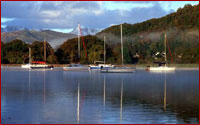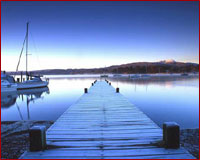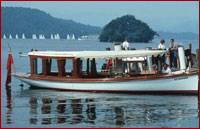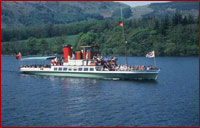 |
|
 |
|
 |
||||||||||||
|
||||||||||
Discover the Lakes The Lake District is England's only true mountain region and contains some of the most stunningly beautiful scenery in the land. The valleys which radiate from the central massif of mountains contain long, deep, glacially formed lakes which provide a marvellous contrast to the spectacular peaks and give the area its name. 
The scenery in the Lake District never fails to leave the visitor with a sense of awe, and an understanding of why this landscape inspired a generation of poets. The physical beauty, abundance of fauna, striking flora and native wildlife makes the county of Cumbria, and the Lake District National Park, the most attractive destination in the United Kingdom today. There is so much to see and do within this part of the Lake District, and we have tried to provide an idea of the range of activities and places to visit to help you plan your stay with us. 
Cruising on the Lakes... There are four lakes upon which you can enjoy a relaxing cruise: Windermere 
Ullswater Derwentwater 
Coniston Literary Heritage Children's author, Beatrix Potter also lived and worked in the Lake District, although not until after the publication of many of her books. Several of the locations in her books are Lakeland ones, and many landmarks are recognisable from her original drawings. The Beatrix Potter Gallery, in the centre of Hawkshead, and Hill Top, the farmhouse where she first lived in the Lake District, are both open to the public. John Ruskin, the artist, writer and critic lived for the latter part of his life at Brantwood, which stands on the East Side of Coniston water. The house is now open to the public, and well worth a visit. Several other literary heroes are associated with the Lake District, including Hugh Walpole, Arthur Ransome, Harriet Martinique, and more recently, the poet Norman Nicholson. More Places to Visit If stepping back in time to re-live boyhood memories of days gone by is your idea of bliss, then a steam train ride is probably right up your street. You'll be on the right track in South Lakeland, at the Lakeside and Haverthwaite Railway, which boasts the oldest preserved steam loco in the world still able to pull a train. 
At Ravenglass there is the world's smallest regular passenger railway. The Ravenglass and Eskdale railway serves the communities of the Eskdale Valley, and runs on 15 in gauge track. The seven mile journey from the coast to the foot of England's highest mountains takes about 35 minutes. The Romans occupied the Lake District for 350 years, and left many landmarks for modern day tourists to visit, including one of the world's most famous historical sites :- Hadrian's Wall. The wall started close to Carlisle, and it's remains at Birdoswald fort are easily accessible from the Lake District. Closer to Hawkshead, the Roman fort at Galava, (Ambleside), is still visible today, as are traces of the Roman road that led from Ambleside to Ravenglass. Hardknott fort is situated at the top of Hardknott pass, the old road from Ambleside to Ravenglass, and at Ravenglass itself are the very well preserved remains of a Roman bath house. The Lakeland of 200 years ago was a very different place to that which we know today. Tourism, the regions major industry, did not really exist in an economically viable form, and the inhabitants of the region worked the land and the forests in order to make ends meet. Mining was a major industry, with towns such as Keswick and Coniston being major mining centres. The Fells around Coniston are littered with old mine shafts, remnants of the days when Copper ore was mined from these hills in vast quantities. At Threlkeld, just outside Keswick, is a mining museum that provides a unique insight into this long gone industry. Woodland industries were also prominent, and 5 miles from Hawkshead is Stott Park Bobbin Mill, which was fully operational until the 1960's, and is now a living museum. 
Muncaster Mill, near Ravenglass, can be accessed by taking a short ride on the Ravenglass and Eskdale Railway. Here, flour is made the traditional way, and you can buy a bag that you have milled yourself. There are many large houses in Lakeland, each with it's own family history. Two of the most interesting are Holker Hall, home of the Cavendish family. As well as the house, you can also visit the gardens, and the hall includes the world famous Lakeland Motor Museum. Muncaster Castle, close to Ravenglass, is reputed to be England's most haunted castle. It is open to the public daily, as are the adjoining garden centre, and Owl Centre, which is worth the admission fee in it's own right. Walk or cycle to some of Lakelands top attractions, whether it be the famous local beauty spot of Tarn Hows or the wide open spaces of Grizedale Forest, home to the famous 'sculpture trail' with an impressive 86 exhibits. With over 6000 acres to explore and over 50 miles of tracks for walkers, mountain bikers and natural history enthusiasts, the area is an ideal location in which to unwind and relax. Thanks to the Cumbria Tourist Board for the photographs. |
|
Home |
About Us |
History |
Finding Us |
Fishing |
Enquiries |
Links |
Announcements |
Events |
Discover the Lakes
|
||
| Your Privacy | ||
Mrs A.J.Walton · Ann Tysons House · Wordsworth Street · Hawkshead · Cumbria, LA22 0PA Telephone: 015394 36405 · Email: stay@anntysons.co.uk |
||
|

